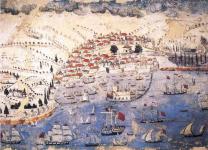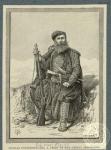

The “palimpsest” city of Heraklion with
its many names has been aptly described as “Mother of the West and the most
beautiful city among the cities of the East sited in the entrance of the East”
After a long siege (1648-1669), the
Venetian Candia along with the neighboring Fortezza (Inadiye) fortress, were conquered
by the Ottomans and remained under their rule for a substantial amount of time (1669-1898),
except for a short period when they came under Egyptian rule (1830-1840). This
“most pious and god- protected castle” became the “most beautiful of cities,
the holy city of Islam, Kandiye”. The city’s capture was the result of the holy
war (Turkish, Cihat, Arabic, Jihad) waged by the Ottoman Empire which sought to
obtain the backing of the entire Islamic state, and for this reason every
effort was made from the onset to give this “eighth wonder of the world” strong
Islamic character. After all, in the city remained but a few Jews that escaped
the carnage, ottoman soldiers and their Armenians miners (azapides).
After
entering the city from the bastion of St Andreas, the victorious armies of the
conqueror Fazil Ahmet Pasha Kiopruli marched towards the Venetian monastery of
St Francis, the catholicon of which was the first of the city’s temples to be
dedicated to sultan Mehmet IV (Χounciar Tzami = imperial mosque).
The city of Heraklion was the military, economic and
religious center of the island until 1851. It was also the capital of an
expended county which - until 1867- included the four provinces of Lassithi.
The pasha (governor) of the city held the title of Serakeri (Commander) of the
island and Mouxafiti (military governor of the fortified city) and commanded
the divanio (council) of the entire Eastern Crete.
1. gr// Επιτροπάκης Π., gr// Το Ηράκλειο στους Οθωμανικούς χρόνους, gr// Η Οθωμανική αρχιτεκτονική στην Ελλάδα, gr// Αθήνα, gr// 2008, p. gr// 396-397 More
 | 6.1 Crete during the Ottoman occupation | |
|---|---|---|
 | 6.2 Heraklion during the Ottoman period | |
 | 6.3 The rebellion of Daskalogiannis (1770) |